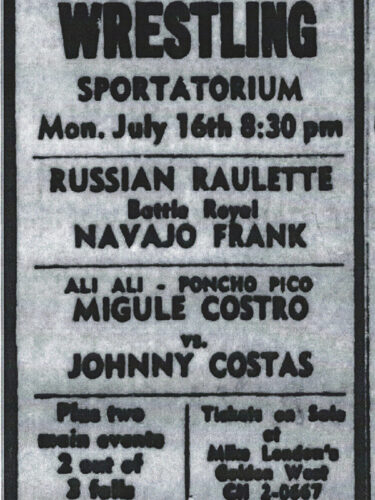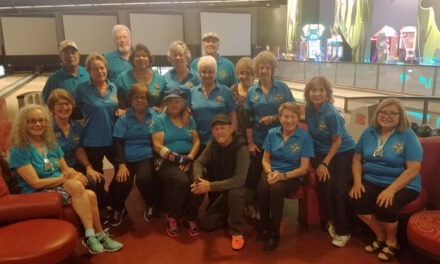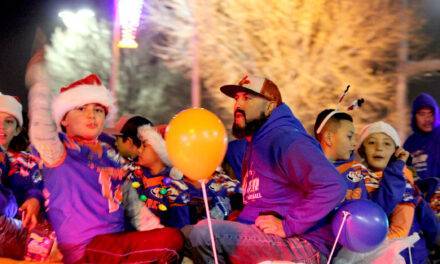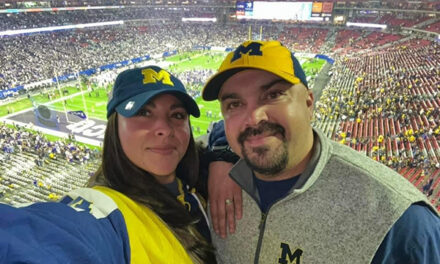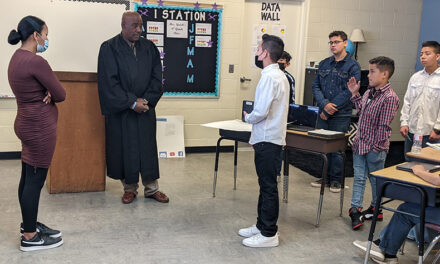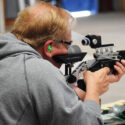La Historia del Rio Abajo
Wrestling fans of the 1960s waited all week for Sunday afternoons when they gathered around their black-and-white television sets to watch live matches telecast from Albuquerque’s Civic Auditorium on KOAT, Channel 7.
What fun to watch wrestling promoter Mike London and his stable of wrestlers with such wonderful names as Gorgeous George, the Funk Brothers, The Sheik and everyone’s favorite, Ricky Romero, who always had some words for “my people” in Spanish.
A whole generation of children grew up with these colorful men as their heroes. Their parents and grandparents shared in the fun.
London and most of these exciting performers are gone now, but one of New Mexico’s most famous native wrestlers is still with us at 92 years of age. Living in Los Lunas, Frank Saiz has countless memories of his career as a pro wrestler, fighting across the country and overseas as Navajo Frank.
Talking to Navajo Frank is like living through those glory days of professional wrestling all over again.
Early days
Frank Saiz was born in Magdalena in 1931. His mother, Teresita, was from the Alamo Navajo reservation while his father, Max, was from Magdalena. Tragically, while working as a bouncer, Max got into a fight that left him blind. The family had seven children. Frank was the youngest boy.
The Saiz family got along the best they could during the Great Depression. Frank left school when he was only 10 years old. He helped his family by working as an underage miner, driving a truck, baling hay and herding sheep and cattle. As he puts it, he received a “street education” that served him well in life.
Working in manual labor, Frank grew incredibly strong. He could lift huge bales of hay, massive telephone poles, pianos and 500 pounds in dead lifts.
Married in 1949, Frank and his wife, Rita, did what thousands of New Mexicans did in the 1940s and 1950s — they moved to California in search of work. Frank landed a job in a Los Angeles paper mill.
Frank’s wife urged him to continue his education in night school, where he befriended several young wrestlers from Mexico and California, who were taking classes to learn English.
Entering the ring
Noticing Frank’s strength, Frank’s new friends urged him to join them in training as wrestlers. Frank trained, although one of the first men he wrestled was an intimidating veteran of the sport who beat him soundly.
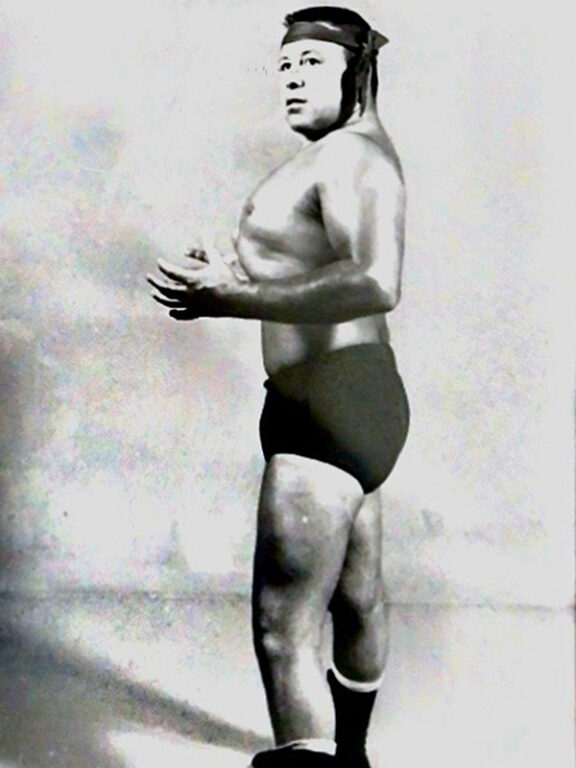
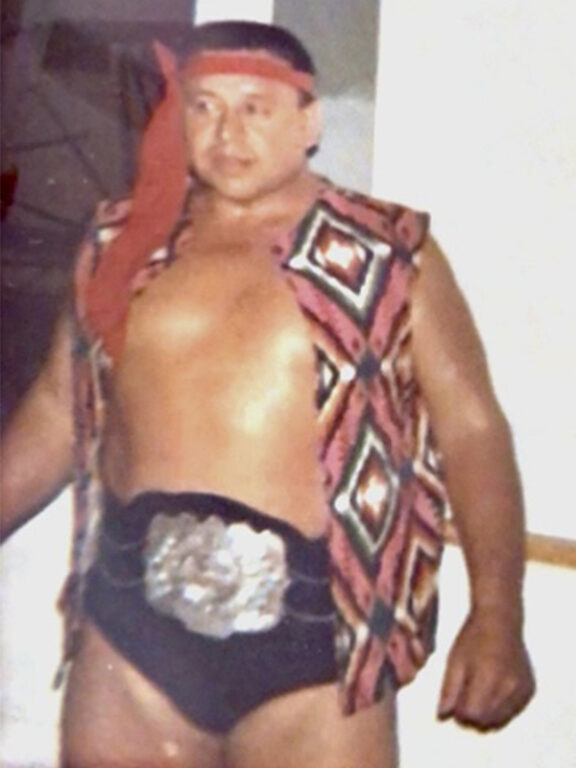
Submitted photos
Navajo Frank Saiz
Not deterred, Frank earned his wrestling license in 1950 and began wrestling in California. He soon returned to New Mexico, where he signed a contract with the famous promoter, Mike London.
London, a former pro wrestler, dominated the sport and his wrestlers for more than three decades in Albuquerque.
Frank knew the advantages of signing a pro-wrestling contract, but resented all the control that he relinquished to London. According to Frank’s contract, London told him when to fight, where to fight and who to fight.
London even controlled Frank’s ring name. Based on his mother’s heritage as a Navajo, London named Frank “Navajo Frank.” Frank usually entered the ring wearing a headband and a vest with a distinctly Navajo design.
Frank remembers that London went so far as to refuse to tell a fellow wrestler that his two sons had died until after the father’s match had ended for fear the man would not fight and fulfill his contract. The man only learned of his sons’ deaths when his match had ended.
While Frank often fought in towns like Tucson, Phoenix, Gallup, El Paso and Albuquerque in the Southwest, he spent most of the year wrestling in towns and cities across the country—wherever London told him to go next.
Frank fought as far east as New York City and as far west as Anchorage, Alaska. He also fought in Puerto Rico and outside the United States in Canada and Mexico.
Frank especially liked wrestling in Mexico. Filling large arenas, excited crowds were highly animated and loud. The pay was good, and the abundant food was excellent.
Frank and his fellow wrestlers traveled from town to town by car and, sometimes, by plane. Frank fought about once a week, meaning that he was on the road and away from his family much of the time.
Wrestlers were paid a set rate per match plus a percentage based on crowd attendance. TV broadcasts brought good extra money.
Surviving in the ring
Wrestling at 5-foot, 11-inches tall, 225 pounds, Navajo Frank fought against contenders with such colorful names as The Vampire, Lucky Lucero, Big Gypsy Bibiano, Fritz and Waldo Von Erich, Russian Roulette, The Assassins, The Mexican Mad Mongol, The Hurricane and Gory.
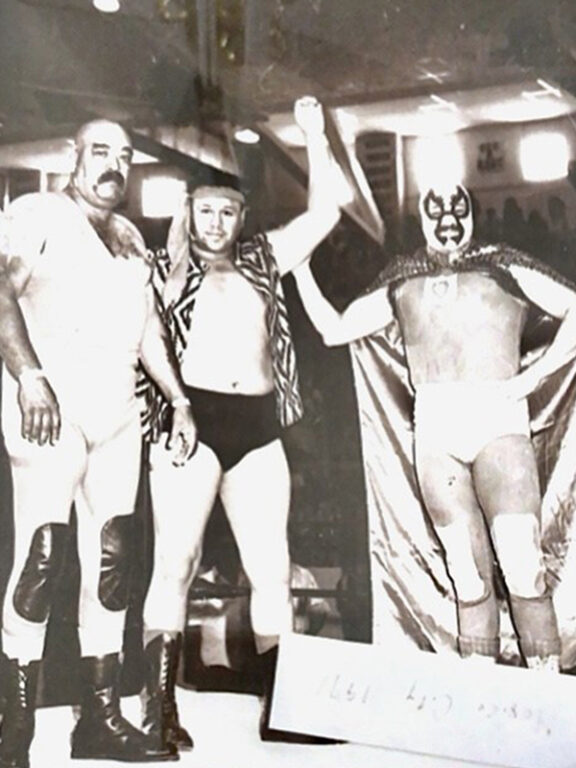
Unidentified wrestler, Navajo Frank and the Fireman.
Frank also remembers his many tag team partners, including Tito Montez and the mysterious Mr. X. Masked, Mr. X’s identity was kept such a guarded secret that not even Frank knew who his partner was. All Frank knew was that Mr. X came from California and always helped draw large crowds.
Depending on the composition of the crowd, Frank played the role of either a hero or a villain. If cast as the villain, he wore masks into the ring. He never liked wearing masks because they made it difficult to breathe; however, the great advantage in wearing a mask was that a riled-up crowd could not recognize you when you took the mask off after a fight and attempted to leave the parking lot anonymously.
Promoters did just about anything to draw large crowds. Mike London arranged for Frank to fight his most unusual foes — two midgets and a black bear.
Frank wrestled two midgets from Mexico in tag team matches. Frank recalls that the men were small, but always strong and dangerous in the ring.
Most sensationally, Frank fought a 700-pound black bear named Samson the Wonder Bear. Bear wrestling had been going on in the United States for at least a century. The largest, most famous fighting bear was known as Terrible Ted.
The first time that Frank wrestled the Wonder Bear, the animal’s owner, Rip Tyler, cautioned Frank to never tease his huge opponent. Despite this sound advice, Frank recalls that he teased the Wonder Bear as soon as the bell rang to start their match. Wonder Bear reached out his enormous paws and knocked Frank across the ring.
Frank and other wrestlers survived their bouts with the Wonder Bear because he had neither teeth nor claws. The bear’s compensation for each fight? His favorite refreshment — a bottle of Coke. (Wrestling bears is now banned in New Mexico.)

Navajo Frank wrestled a 700-pound black bear named Samson the Wonder Bear.
Frank says two things were essential to a wrestler’s success in the ring: First, it was important to know all the best wrestling moves, from the drop kick and the body press to the cobra claw, which could render an opponent unconscious or even kill him if you were not careful. Using an effective body press, Frank pinned Gypsy Bibiano in as little as 7 1/2 minutes in a match held in early 1965.
It was equally important to know how to counter your opponents’ moves. Frank still recalls how to break a headlock and an iron claw to help prevent injuries to himself and others.
Of course, injuries were inevitable in such a violent sport. In the course of his long career, Frank suffered a broken leg, a broken back, concussions, a split head and the loss of his top front teeth, the victims of a knee to his face during a bout in California.
Frank says his father never attended his matches, but Mike London arranged for Frank’s mother to witness a match in Shiprock. London might well have anticipated Frank’s mother’s reaction when she saw her son getting hurt in the ring. Frank vividly recalls her climbing the ropes to try to stop the fight.
Many wrestlers liked to rile up a crowd before they entered a ring. On one occasion, Frank had said things that so enraged a crowd that he ran for the back door to flee. The door was locked. The crowd attacked, throwing metal folding chairs at the cornered fighter. Somehow, he escaped.
Fans could be so unruly that extra precautions had to be taken to protect the wrestlers. In 1973, chicken wire had to be installed around the ring to shield Frank and his opponent, The Vampire, from flying objects launched by nearly 400 rowdy fans in Gallup.
With rare exceptions, wrestlers did not take money to fix fights. Like all good performers, their job was to provide enough exciting entertainment that their audiences were pleased and eager to come back for more.
Looking back
Frank wrestled his last match when he was 61 years old. He claims that he lasted so long because he never drank, smoked or took drugs.
Frank and his family lived in Peralta for many years. He had good neighbors, including the renowned guitarist and singer Bo Didley.
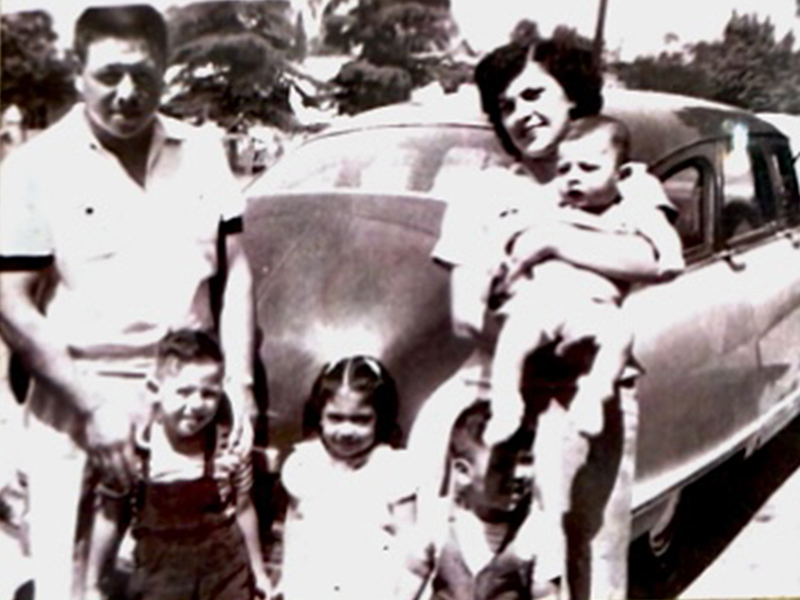
Frank and Rita Saiz and members of their young family.
Frank now lives in a fine house he built in Los Lunas. Frank raised four children, Cisco, David, Rudy and Rachel, and three step-children.
When not wrestling, Frank worked hard as a plumber, an auto mechanic and an expert at fixing boilers in Albuquerque and at the Los Lunas Hospital and Training School. He even worked as a boxing promoter in the mid-1970s.
Frank does not admire the professional wrestling world of today. He realizes that pro wrestling is largely entertainment but, in his day, it was also a skilled sport. Now it is mostly a glitzy show filled with smoke and mirrors but few true athletes.
Navajo Frank concludes that he had a wonderful wrestling career. With the possible exception of broken bones, concussions and his least favorite fighting venue (a certain island in the Caribbean), he would not have changed a thing.
(La Historia del Rio Abajo is a regular column about Valencia County history written by members of the Valencia County Historical Society since 1998.
The author appreciates the generous assistance of Bobby Ulibarri, Matt Baca, Rachel Romero, Frank Saiz’s daughter; and Monique Romero, his granddaughter.
Opinions expressed in this, and all columns of La Historia del Rio Abajo are the author’s alone and not necessarily those of the Valencia County Historical Society or any other group or individual.)
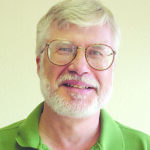
Richard Melzer, guest columnist
Richard Melzer, Ph.D., is a retired history professor who taught at The University of New Mexico–Valencia campus for more than 35 years. He has served on the board of directors of the Valencia County Historical Society for 30 years; he has served as the society’s president several times.
He has written many books and articles about New Mexico history, including many works on Valencia County, his favorite topic. His newest book, a biography of Casey Luna, was published in the spring of 2021.
Those interested in joining the Valencia County Historical Society should contact Dr. Melzer at [email protected].
